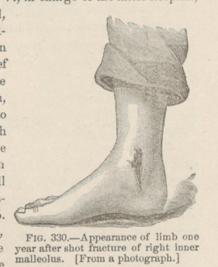Title: Dullahan, J.
Source text: The Medical and Surgical History of the War of the Rebellion. (1861-65.), Part 3, Volume 2 (Washington, DC: Government Printing Office, 1883), 579.
Civil War Washington ID: med.d2e21478
TEI/XML: med.d2e21478.xml
CASE 815.—Private J. Dullahan, Co. D, 3d Vermont, aged 24 years, was wounded in the right ankle, at the Wilderness, May 5, 1864. Six days after receiving the injury he was admitted to Harewood Hospital, Washington, and one week later the man was transferred to South Street Hospital, Philadelphia. Surgeon S. J. W. Mintzer, U. S. V., in charge of the latter hospital, recorded a wound of the ankle with compound fracture of the inner malleolus by a minié ball, which entered at the inner malleolus and came out just behind the external malleolus. Cold-water dressings were used. On May 23d there was great pain and swelling, and an application of lead water and laudanum was kept wrapped around the limb; morphia, milk punch, and beef essence being administered. Two days afterwards the wounds of exit and entrance were enlarged, after which the foot was again wrapped up in the same application. On May 27th, the pain still continuing, equal parts of tincture of aconite and water were applied, and two days later a plaster of extract of hemlock was made to cover the entire foot. On May 30th quinine pills were prescribed, and another lotion consisting of laudanum and tincture of aconite was ordered to be constantly applied. The entries in the hospital records at this date mention that the patient was evidently sinking. He subsequently mended, however, and became well enough to be transferred to Brattleboro on June 29th. Several months later he was transferred to Burlington, where he was assigned to the Veteran Reserve Corps February 21, 1865. The patient was ultimately discharged from service at Sloan Hospital, Montpelier, July 25,1865, and pensioned. Surgeon H. Janes, U. S. V., in charge of the latter, contributed the photograph represented in the adjacent cut (FIG. 330), and reported that, according to the patient's statement, the lower end of the tibia became necrosed and was gouged out twice at Brattleboro Hospital. At the time of the man's discharge his general health was good and the wound was nearly healed, with ligamentous anchylosis of the joint and very slight contraction of the muscles of the calf of the leg. There was no appearance of caries or necrosis, and he could walk a short distance with a cane, gaining some motion of the joint by exercise. Examiner A. L. Lowell, of Burlington, Vermont, certified, March 26, 1870: "The cicatrix of entrance is adherent to the bone and healthy, but sensitive to pressure. The inner malleolus is considerably thickened by bony deposit and the new growth is operative in limiting the motions of the foot. The tibio-tarsal articulation is obstructed in its function by false anchylosis. In flexion and extension of the foot the toes describe an arc of but two inches. The foot is inverted to such a degree as to throw the weight of the body on the outer margin of the sole." The pensioner was paid June 4, 1880.


